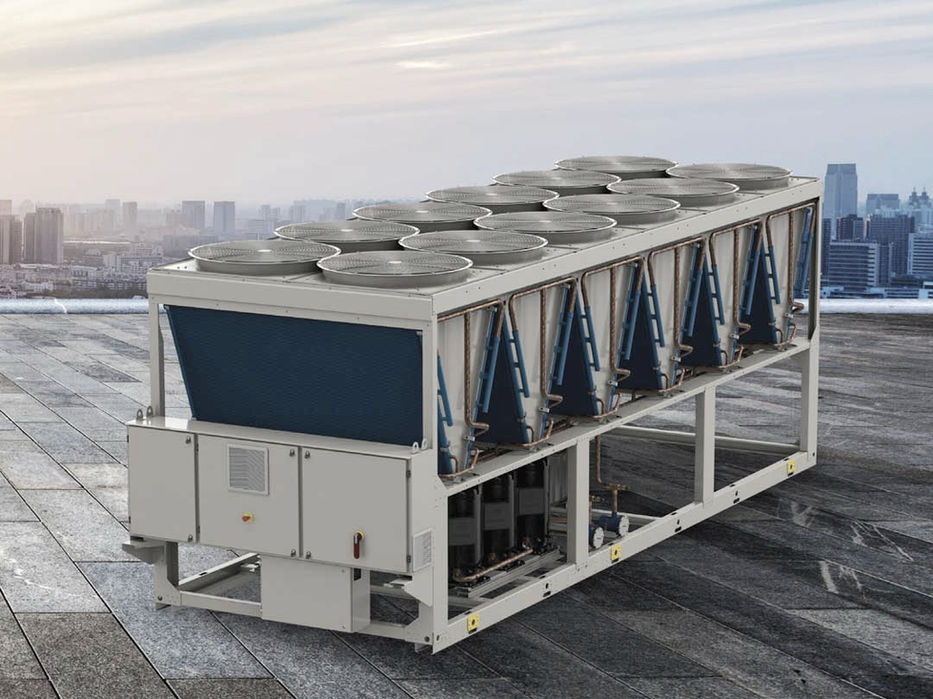Thermodynamic Fundamentals Design
HOW THE SOFTWARE WORKS?
GOAL ORIENTED DESIGN
I-CHILL DESIGN is an advanced software for product design and selection in the HVAC, data center, refrigeration, and industrial process sectors (such as Chillers, Heat Pumps, Multifunctional Units). It is an evolutionary-type tool developed to revolutionize the traditional design workflow.
Unlike competitor software, which mainly works as a verification tool requiring users to preselect all components,
I-CHILL implements a reverse and predictive methodology.
Starting from desired performance and dimensional goals (cooling capacity, efficiency, footprint), the system uses optimization algorithms and an integrated component database to automatically generate, within seconds, a range of technically valid and optimized configurations.
I-CHILL DESIGN is dedicated to HVAC engineering and R&D, applying an algorithmic, goal-oriented design approach.
Architecture and Data Flow
The system is based on a centralized relational database that serves as a single source of truth for all company departments.
The architecture has three main layers:
Calculation Layer (Engine): The core of the software, containing thermal balance and optimization algorithms.
Component Database: A large, hierarchical database containing mathematical models and performance data for compressors,
heat exchangers (evaporators, condensers), fans, expansion valves, and other components.
User Interface (UI): An intuitive dashboard guides the user in defining specifications and displays generated solutions.
Calculation Engine (ENGINE)
The ENGINE is the heart of I-CHILL DESIGN, known for rigor, speed, and precision.
Heat Exchanger Methodology: Heat exchangers are modeled using a multi-zone infinitesimal approach (NTU-ε method and local balances). The refrigerant path is divided into many finite intervals.
For each, the software solves a system of equations including:
-
Energy balance and conservation equations
-
Mass balance equations
-
Heat transfer equations (rigorous calculation of convective coefficients for subcooled liquid, two-phase, and superheated vapor regions)
-
Pressure drop equations
Refrigerant thermodynamic and transport properties are calculated in real time for each local condition using integrated reference libraries (CoolProp).
Fan Management: The model includes the fan P-Q performance curve. The software determines the optimal operating point, adjusting airflow (or frequency for inverter fans) to balance heat transfer and absorbed power, maximizing seasonal efficiency.
Compressor Models: The database includes full multidimensional performance maps for compressors (hermetic, semi-hermetic, rotary, scroll, screw, Turbocor). For inverter and Turbocor compressors, the algorithm optimizes and selects the best operating frequency to reach the required thermodynamic point while minimizing specific energy and maximizing efficiency.
Expansion Valve Calculation: Refrigerant mass flow and nominal power required for the valve are calculated using correlations such as m˙=CvΔp·ρ, ensuring target superheat both at design and off-design conditions.
Integration with Company Departments (Platform Module)
SALES Users (I-CHILL SELECTION):
Accessory List: Automatically proposes compatible standard accessories (control panels, hydraulic kits, etc.) with pricing options.
AI-Generated Descriptions: AI analyze the configuration and generates detailed technical-commercial descriptions, editable and customizable.
Catalog Creation: Export configuration, renderings, and specs in catalog/technical datasheet formats. An optional app allows strong customization of product description and graphics.
Engineering Users (I-CHILL Engineering Hub):
Attach final dimensional drawings (2D/3D) and electrical diagrams to unit records.
Define the machine’s operating envelope (temperature interaction limits of working fluids).
Marketing Users (Approval):
Marketing/sales management can review and formally approve units for release to the sales network.
I-CHILL SELECTION:
Fully integrated with DESIGN. Sales users can query approved units, filtering by performance, dimensions, and features, to quickly find the right unit for a specific application without redesign.
Functional Specifications of the Design Module
Project Input (simplified and goal-focused):
Load Conditions: Flow rates, inlet/outlet temperatures for process fluids (water/glycol side) and condensation fluid (air/water side).
Performance Targets: Required cooling capacity (kW), efficiency targets (e.g., COP, IPLV).
Design Constraints: Coil face velocity, refrigerant type, ambient operating temperature range.
Machine Type: General configuration (air-to-water, water-to-water, etc.), type of compressor, heat exchanger, and fan to use.
Editing Mode
Any automatically generated configuration can be manually modified by the designer:
Replace a component with another compatible one from the database.
Modify operational parameters (fan speed, subcooling/superheating setpoints, etc.) .
Update boundary conditions and recalculate performance.
Output – Reporting and Visualization
For each configuration, the software generates a detailed report including:
Thermodynamic Report: Full technical operating data — cooling/heating performance, flow rates, pressure drops, evaporation and condensation temperatures/pressures, fan airflow. Data are compliant with EUROVENT, ERP, AHRI standards.
Component Data: Model/brand of compressor (with frequency if applicable), heat exchanger data (surface area, number of circuits), fan details (flow, static pressure, absorbed power), expansion valve specs.
Performance Indicators: Cooling capacity, absorbed power, EER, COP, SEER, SCOP, SEPR, IPLV, NPLV, controllability, flow rates, losses, electrical data, etc.
Dimensional Estimate: Approximate footprint and weight.
Advanced Energy Calculations: Automatic calculation of efficiency indices (AHRI, ISO) including SEER, SCOP, SEPR, IPLV, NPLV, based on user-defined load curves. The Energy Analysis tool also evaluates product efficiency according to installation
System Requirements and Certifications
I-CHILL DESIGN runs on MS Azure or Amazon servers, with access controlled by administrator-defined user profiles. Authentication and authorization use differentiated roles (Designer, Engineer, Sales, Admin, etc.).
Certifications
I-CHILL DESIGN results comply with the most widespread certifications:
EUROVENT
ERP
AHRI
.png)







